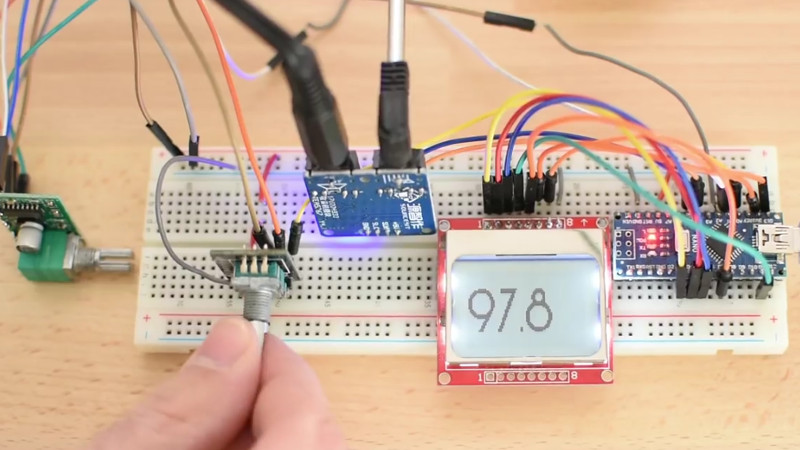Taking a vintage radio and cramming it full of modern, Internet-connected, guts has long been a staple of the hacking and making scene. While some might see it as a crime to take what’s arguably a legitimate piece of history and turn it into nothing more than a slipshod case for the Raspberry Pi, we have to admit there’s a certain appeal to the idea. Taking the beauty of classic design and pairing it with more modern capabilities is getting the best of both worlds.
But this project by [Nick Koumaris] is a somewhat unique take on the concept. Rather than sacrificing a real vintage piece of hardware to house the electronics, he’s designed a 3D printable case that looks like a classic 1936 AWA Radiolette. But what’s really interesting to us is that he then puts a basic FM radio inside of it.
That’s right, no Internet radio streaming or smartphone Bluetooth compatibility here. It’s just a regular FM radio, not entirely unlike the kind of hardware you’d expect to be inside of a classic radio. Of course, it’s much more modern, and [Nick] actually built it himself from a TEA5767 FM radio module and an Arduino Pro Mini.
While functionally it might not be terribly exciting, we do appreciate that he went through the trouble to make a vintage-looking user interface for the radio. While physical buttons would arguably have been more appropriate given the era, the art deco inspired font and graphics that show on the device’s Nokia 5110 LCD do look really slick.
Purists will surely be happy to see another project where a piece of vintage piece of audio equipment wasn’t sacrificed at the Altar of Hack, but we’ve also played host to many projects which weren’t nearly as concerned with historical preservation.
















fun concept, but when I first saw the hackaday image of the radio case. I thought “wow! That’s a nice case, cool design… and in wood, nice job” but I can’t see the case in the article. It looks to me that a 3D rendering is the only thing there is. So in other words… nothing in wood (yet) only some intentions of a case in wood filament, which I’m very curious how that will look like. As the design itself is very pretty and I hope a video will come online of the final result. Now this is a cliffhanger! (well done)
Yeah, this is cool. I like the details, great job.
I’m in the same case… pun intended… with many RF and Computer projects that need to be housed in cases and I have some though haven’t moved forward on determining say with the RF projects… custom machining internal block sections or modules cases to lower noise or use the extruded cases and custom machining cases on existing boards to lower noise and still thermal transfer and like the computer projects… what to use as a case. With the RF and even computer custom cases, I left off with needing to find RFI/EMI gasket material. I did pick up copper braid for wiring.
I just today picked up a not planning to be shielded or low noise SOYO case (with the single hand grip on top) that I used to use in some of my custom computer builds… though that isn’t so antique deco and will house the IBM PC 350 and my socket 5/7 kit test runs (I figured I’d learn some electronics signals on my old systems since I don’t have fast enough scopes yet to see the newer boards). I’m going to do some learning down in the FM broadcast MHz range also. :-|)
Really neat learning with the Arduino’s… then stepping back in time with and connecting the dots (bridging thought comprehension gaps) with older computers I used to use and didn’t get that detailed regarding the electronics and RF engineering.
Lots of potential and here is a good example with detailed resources and 3D printing a case.
He did provide the design files: https://www.thingiverse.com/thing:2826999
So if you can”t wait …
Yep, found these, very convenient indeed. Thanks for mentioning, got to buy myself some wood filament soon.
That is a very detailed description of his project over there. He lists everything required to build the radio, and where to obtain them. That is the most info I have seen in a Thingiverse posting. Thanks.
I really like the case and the grille in particular. Really gives it that classic flair. Kudos, Nick!
That’s a classy project. I appreciate he didn’t sacrifice another classic radio cabinet and the effort to use an art deco numerical font was a nice touch. What’s odd is that he made it FM only when adding in Bluetooth or wired in would have made it more versatile without a lot of extra hardware.
Our last AM got a translator, so AM is dead here in town. However the FM band would be a mess with one of the one chip wonder FM radios with that translator two clicks away from our NPR station.
From the picture it’s a nano, not a pro mini, as the latter wouldn’t feature the usb micro port clearly visible. Of course those boards a quite similar, but hey – precision :)
As per the Bill of Materials, the final design calls for a Pro Mini. Presumably he’s using the Nano for development on the breadboard as he gets the software/wiring nailed down.
Reasonable. The USB Option is nice to do some quick development, but hogs some current.
As the Pro Mini is identical to the Nano bar the USB, that’s a good replacement for “production” use.
‘much more modern’ – discuss